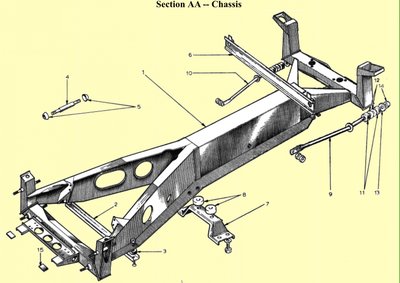Plus 2 Ride Height Measurement to ?Closing Plate?
4 posts
• Page 1 of 1
The WSM indicates Plus 2 ride height should be 6 1/2? to the closing plate when setting alignment. Where exactly is said closing plate? Would it be a different item on my Spyder space frame?
At a guess is it the welded rectangular plate at the base of the front towers? If so, they are sloped on my Spyder chassis, so which side I wonder? Of course the front cross member is cylindrical on the the Spyder, but I suppose that could be called a closing plate on the stock frame? Surely they don?t mean the closing plates located in the wheel wells that create the plenum for the side rails?
Just got the alignment checked and adjusted, and the tech mentioned my front spring height is adjustable, and car ideally should be raised in the front. I agree as the front wishbones are definitely not level by about an inch when quickly checked with a spirit level and the alignment sheet shows -2.0/-2.1 negative camber unweighted rather than 0 to +1 degree positive as per spec, weighted. The front looks pretty slammed for sure!
Bonus would be help with my 2? exhaust clearance.
Cheers!
Stu
At a guess is it the welded rectangular plate at the base of the front towers? If so, they are sloped on my Spyder chassis, so which side I wonder? Of course the front cross member is cylindrical on the the Spyder, but I suppose that could be called a closing plate on the stock frame? Surely they don?t mean the closing plates located in the wheel wells that create the plenum for the side rails?
Just got the alignment checked and adjusted, and the tech mentioned my front spring height is adjustable, and car ideally should be raised in the front. I agree as the front wishbones are definitely not level by about an inch when quickly checked with a spirit level and the alignment sheet shows -2.0/-2.1 negative camber unweighted rather than 0 to +1 degree positive as per spec, weighted. The front looks pretty slammed for sure!
Bonus would be help with my 2? exhaust clearance.
Cheers!
Stu
Stu
1969 Plus 2 Federal LHD
1969 Plus 2 Federal LHD
-

stugilmour - Coveted Fifth Gear

- Posts: 1944
- Joined: 03 Sep 2007
To set my ride height, prior to setting all toe and camber settings, I place the equivalent of my weight in concrete blocks in the driver's seat (my wife doesn't travel in the +2 much these days !) plus say a third full petrol tank. I adjust the springs on each corner to make the lower wishbones horizontal. The adjustments on the driver's side should be a little higher than the passenger side, and approximately equal, to avoid any diagonal bias, in the absence of corner weight scales.
(The as-built camber and rear toe settings on the Spyder chassis were all way out, so I have fitted fully adjustable wishbones all round)
I measure the height of the sill edge at each corner for reference. I may lower the car some more by winding back an equal amount on each corner.

(The as-built camber and rear toe settings on the Spyder chassis were all way out, so I have fitted fully adjustable wishbones all round)
I measure the height of the sill edge at each corner for reference. I may lower the car some more by winding back an equal amount on each corner.
68 Elan +2, 70 Elan +2s
-

Foxie - Coveted Fifth Gear

- Posts: 1210
- Joined: 20 Sep 2003
Thanks Foxie. I think I will take a similar approach. How high did the bottom of the side sill lip end up on your car?
Stu
Stu
Stu
1969 Plus 2 Federal LHD
1969 Plus 2 Federal LHD
-

stugilmour - Coveted Fifth Gear

- Posts: 1944
- Joined: 03 Sep 2007
Foxie wrote:(The as-built camber and rear toe settings on the Spyder chassis were all way out, so I have fitted fully adjustable wishbones all round)
I'm interested in this, in particular was the bare chassis assembled to the body prior to drilling & tapping or was this done with the body dropped onto a rolling chassis. I have noted (spyder chassis) that the rear legs flex significantly if you remove the rear strut brace along with the complete suspension, driveshaft ,etc. assembly.
I believe Buckland suggests (on the Elan) fitting the bare chassis, whereas any factory pictures I've seen suggest the rolling chassis... is this where some of the inconsistency arises ,which is considered the correct process and does the wider track of the plus 2 amplify the issue.
Stu, I do apologise if this is a thread drift
Adrian
1968 Elan plus 2 - project
2007 Elise S2 [modified with a Hethel 70th sticker (yellow)]
2000 Elise S1 - Sold
2007 Elise S2 [modified with a Hethel 70th sticker (yellow)]
2000 Elise S1 - Sold
- wotsisname
- Third Gear

- Posts: 452
- Joined: 24 Jun 2015
4 posts
• Page 1 of 1
Total Online:
Users browsing this forum: No registered users and 8 guests

